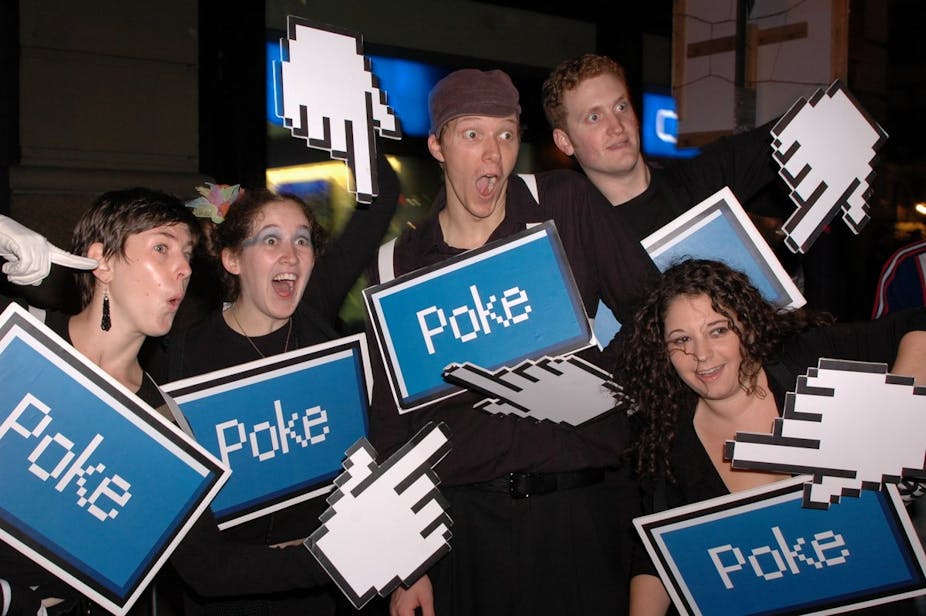Is it possible to socially interact with another person in the absence of a body and the senses? Social networking allows us to present versions of ourselves. But when we use a computer to mediate our communications, are we interacting with another human being or with that machine?
Many people really do only see the computer as a mediating agent when they talk, share or watch others online. The machine merely acts as a intermediary that allows this kind of exchange to happen between different people. This is true in some respects. But as more and more social interactions start to become mediated online, our experiences are increasingly becoming virtual, not material.
Plenty of people are starting to feel as though what they are doing in the here and now only finds meaning when it is expressed virtually elsewhere. Suddenly, posting a photo of the concert you are attending or the landmark you are visiting becomes more pressing than actually experiencing the event first hand. What is in effect happening when people socially exchange via computers is best understood as a collective out-of-body experience. The whole self is evacuating the moment when we communicate online.
On average, US citizens spend 6.5 hours online each day. Facebook for example has 1.5 billion users and 1 in 13 of the world’s population. In June 2013, 819 million monthly active users used Facebook mobile products and there were 699 million daily active users on average. Around 700 billion minutes a month are spent on Facebook and each day 35 million users update their status. And this is just Facebook. Around 500 million tweets are broadcast every day by more than 200 million active users.
Then there are online dating agencies, news websites, gaming, blogs and special interest social networks. Even those who do not post directly into sites such as Facebook are often monitoring what others are doing on the site. They might not be active, but they are still there. We are online before we are even born, when our parents post images of their prenatal scans on Facebook, and we are there after we die, as our online friends find ways to remember us.
But is any of this actually social interaction? To be social is to have a relationship with someone and be present in that exchange with the whole of the self. As an exception to the rule it is OK to have these disembodied moments of social exchange - a telephone call, email, and to engage in an online social network, but what is happening when these events are no longer the exception but increasingly the norm?
When we communicate online, we are presenting carefully selected parts of ourselves. We are able to trim back large parts of our personality and present only the side that is relevant or desirable to a given online interaction. In cases where we are not close to the person, in offline physical interactions we are bound by the time, space and place of the interaction, so it acts as a container for our being. In online social networking, there is no aspect of the experience where the self is fully engaged. It is always out of body.
Interaction in this detached way is not much a problem as a part of everyday experience, if it is transitory and partial. We know from studies in anthropology, performance arts and psychology that temporary detachment from the self is not necessarily problematic.
One of the problems with increasing online interaction is a diminished sense of responsibility towards, concern for and appreciation of others. People say things in emails and in online networks they would never say in person - if they were really present with another. This becomes apparent when we read the comments left on websites and the cruelty that is expressed online. If you can hide behind a mask, and your thoughts and your opinions are not tied to yourself, you can abandon responsibility for what is happening and what you are communicating.
What is absent in the online mediated social interaction is the whole person, the sensuous, embodied individual, contained and held in time, space and place. In 1995 Nicholas Negroponte wrote Being Digital, in which he made a distinction between “atoms” and “bits”. Atoms are physical things, whereas bits are pieces of digital information.
When the web emerged, many commentators celebrated the emancipation from time, space and context but that celebration dates back to a time when online interaction was an addition to rather than replacement for our offline lives. As the proportion of time spent online begins to equal or surpass time spent offline, we may need to ask ourselves what it is about our offline lives that is failing to deliver and driving us to interact via machines.

